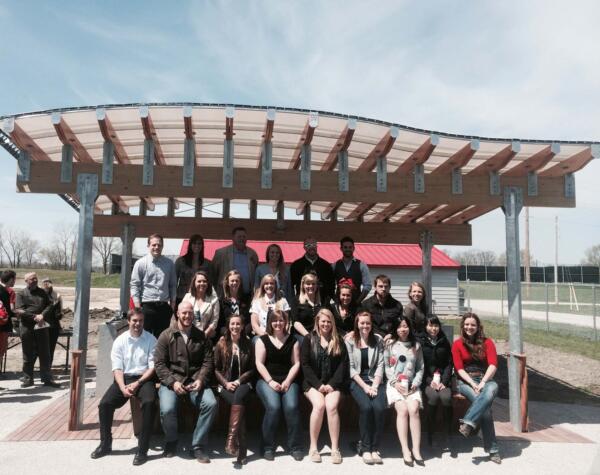Iowa State University Students Get Real World Experience with Architecture & HDG

Students at Iowa State University got to experience a once in a lifetime learning experience through a class called the Design Build Option Studio offered at the College of Design. The studio class combines students from architecture, landscape architecture, and interior design who come together to build a project which forces collaborations among the students who have different designs, styles, and focuses. This year, 22 students were tasked with designing, developing, and constructing a project for the Iowa State University Recreation Service Department under the direction of Iowa State University, College of Design Professor Bruce Bassler.
The Iowa State University Recreation Services wanted a pavilion for the schools club sports team fields. The campus is revitalizing the area that used to house the baseball fields, and the pavilion the students designed is a shelter area with benches and a water station for the club teams. The Recreation Service Department funded the entire project, but gave complete design freedom to the group of students. They stressed that this project was to be designed by students, built by students, and used by students because the funding for the project would come from ISU student fees. The Recreation Service Department wanted students to take ownership in the success of the projects design as the end users of the pavilion would be current and future students.
The first phase of the project was to come up with a design. This was a challenge from day one. Everyone had many great ideas that focused on different parts of the design and different elements that pertained to their own program of study; condensing this idea into one project was really difficult, Kelsey Vetter, a junior architectural student said. One of the key learning objectives during this phase of the project was constructability. The students quickly realized manydesigns look better on paper and need to have highlydetailed design work in order to be feasible.
They were reminded of this during the design and erection process, but with the guidance of Professor Bassler and Howes Welding and Metal Fabrication, the students finalized a design to meet the projects needs.
Throughout the design process, one major decision was what building materials to use. The students decided on steel for the main component of the project. After deciding on steel, the students began evaluating finishes or coatings. Their goal was to find a coating that would extend the life of the project, be durable, sustainable, and compliment any other materials chosen.
The students werent familiar with galvanizing, but other studio classes had used it in the past. Once introduced to hot-dip galvanizing, the students chose it because it met and exceeded their needs, and other alternatives such as paint, didnt compare as they would have required more maintenance and less durability at a similar price. As the students were unfamiliar with hot-dip galvanizing, they had to learn about fabrication, design, and prepping the steel for the dipping process. With the help of the American Galvanizers Association and Valmont Coatings, who taught the students about venting, oversizing holes, and other design practices, the students were able to successfully design the project.
The students fully participated in the fabrication of the steel and other materials. Many students had no prior experience with fabrication machines, wood working tools, or pouring concrete. But the studio class is hands-on learning, so the students pushed forward following budgetary constraints, fulfilling client requests, and working as a team to put the project on site.
This learning experience opened the students eyes to the real world of architecture and engineering. It was a chance for these students to work hands on with the design and construction, and work with a team of a variety of different people with different backgrounds. This was the first time students had a real project with real clients, budgets, choices, and challenges moving them a step closer to the professional experience they will soon have in their careers. Overall, everyone walked away with new skills that can be applied to manual construction tasks in the future as well as new skills in thinking and problem solving that will forever effect the way they design, Professor Bruce Bassler said.
The pavilion was unveiled to the Iowa State University Recreation Service department on Saturday, May 10, 2014. Thanks to the hard work of these 22 students, determined to make the project a success, the pavilion will be a reprieve for current and future clubs.
The AGA is committed to educating current and future specifiers in various ways through our Education and University Programs which include our Continuing Education seminars, Galvanize Your Campus initiative, Scholarship Program, Can You Dip It Video Showdown, and more.

